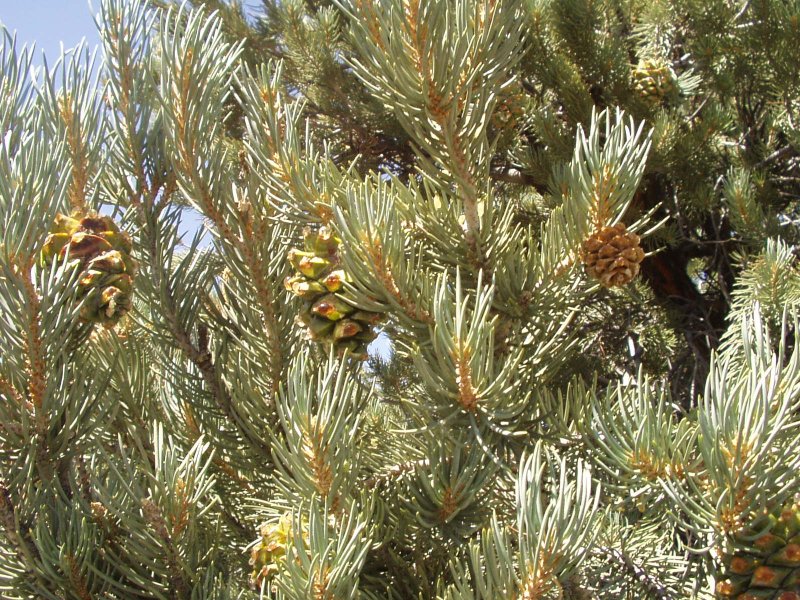- Single-leaf Pinyon
Taxobox
name = Single-leaf Pinyon
status = LR/lc | status_system = IUCN2.3

image_width = 240px
image_caption = Single-leaf Pinyon ("Pinus monophylla" subsp. "monophylla") leaves and immature cones
regnum =Plant ae
divisio =Pinophyta
classis = Pinopsida
ordo =Pinales
familia =Pinaceae
genus = "Pinus"
subgenus = "Ducampopinus"
species = "P. monophylla"
binomial = "Pinus monophylla"
binomial_authority = Torr. & Frém.The Single-leaf Pinyon ("Pinus monophylla") is a
pine in thepinyon pine group, native to theUnited States and northwestMexico . The range is in southernmostIdaho , westernUtah ,Arizona , southwestNew Mexico ,Nevada , eastern and southernCalifornia and northernBaja California . It occurs at moderate altitudes from 1200-2300 m, rarely as low as 950 m and as high as 2900 m. It is widespread and often abundant in this region, forming extensive open woodlands, often mixed withjuniper s.It is a small to medium size
tree , reaching 10-20 m tall and with a trunk diameter of up to 80 cm, rarely more. The bark is irregularly furrowed and scaly. The leaves ('needles') are, uniquely for a pine, usually single (not two or more in a fascicle, though trees with needles in pairs are found occasionally), stout, 4-6 cm long, and grey-green to strongly glaucous blue-green, withstomata over the whole needle surface (and on both inner and outer surfaces of paired needles). The cones are acute-globose, the largest of the true pinyons, 4.5-8 cm long and broad when closed, green at first, ripening yellow-buff when 18-20 months old, with only a small number of very thick scales, typically 8-20 fertile scales. The cones open to 6-9 cm broad when mature, holding theseed s on the scales after opening. The seeds are 11-16 mm long, with a thin shell, a whiteendosperm , and a vestigial 1-2 mm wing; they are dispersed by thePinyon Jay , which plucks the seeds out of the open cones. The jay, which uses the seeds as a food resource, stores many of the seeds for later use by burying them. Some of these stored seeds are not used and are able to grow into new trees. Indeed, Pinyon seeds will rarely germinate in the wild unless they are cached by jays or other animals.There are three subspecies:
*"Pinus monophylla" subsp. "monophylla". Most of the range, except for the areas below. Needles more stout, bright blue-green, with few resin canals. Cones 5.5-8 cm long, often longer than broad.
*"Pinus monophylla" subsp. "californiarum" (D. K. Bailey) Zavarin. Southernmost Nevada, southwest through southeastern California (northwest only as far as theSan Jacinto Mountains ) to 29°N in northern Baja California. Needles less stout, gray-green, with few resin canals. Cones 4.5-6 cm long, broader than long.
*"Pinus monophylla" subsp. "fallax" (E. L. Little) Zavarin. Slopes of the lower Colorado River valley and adjacent tributaries fromSt. George, Utah to theHualapai Mountains , and along the lower flank of theMogollon Rim toSilver City, New Mexico . Needles less stout, gray-green, with numerous resin canals. Cones 4.5-6 cm long, broader than long.It is most closely related to the
Colorado Pinyon , which hybridises with it (both subsps. "monophylla" and "fallax") occasionally where their ranges meet in western Arizona and Utah. It also (subsp. "californiarum") hybridises extensively withParry Pinyon .An isolated population of trees in the
New York Mountains of southeastCalifornia with needles mostly in pairs, previously thought to be Colorado Pinyons, have recently been shown to be a two-needled variant of Single-leaf Pinyon from chemical and genetic evidence. Occasional two-needled pinyons in northernBaja California are hybrids between Single-leaf Pinyon and Parry Pinyon.Uses and symbolism
The edible seeds,
pine nut s, are extensively collected throughout its range; in many areas, the seed harvest rights are owned by Native American tribes, for whom the species is of immense cultural and economic importance. During the mid nineteenth century many Pinyon groves were cut down to makecharcoal for ore-processing, destroying the traditional lifestyle of the Native Americans who depended on them for food. When therailroad s penetrated these areas, importedcoal supplanted locally-produced charcoal., because it is difficult to germinate.
The Single-leaf Pinyon is the official state tree of the state of
Nevada , USA.References and external links
*
*Ronald M. Lanner, 1981. "The Piñon Pine: A Natural and Cultural History". University of Nevada Press. ISBN 0-87417-066-4.
* [http://www.pinetum.org/cones/PNDucampopinus.htm Photo of cones (scroll ¾-way down)]
* [http://www.conifers.org/pi/pin/monophylla.htm Gymnosperm Database: "Pinus monophylla"]
* [http://plants.usda.gov/java/profile?symbol=PIMO USDA Plants Profile: "Pinus monophylla"]
Wikimedia Foundation. 2010.
